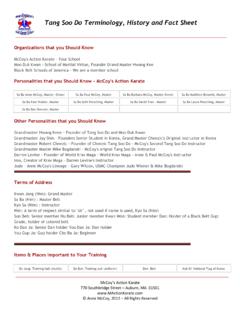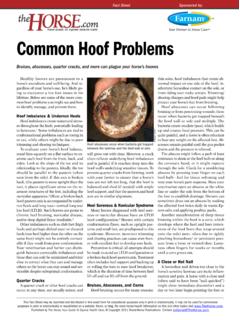Transcription of Ragozin Data & Publishing - The Sheets
1 TABLE OF CONTENTS. Part I. Letter from Ragozin .. 3. Basic Information on The Sheets .. 5. Where to get The Sheets .. 7. How to read The Sheets .. 8. 1996 Belmont Stakes .. 9. Seminar tape order form .. 10. New Accounts .. 11. Customer Service .. 12. Recovery Lines .. 13. Bouncing .. 15. For Owners & Trainers .. 16. Examples .. 17. Part II. The Press .. 24. Ragozin data & Publishing 44-02 11th Street, Suite 617 LIC, NY 11101 Tel: (212) 674-3123 Fax: (212) 674-3732. *Online *Email: Ragozin data & Publishing - The Sheets 2. Welcome to our group, The Sheets are the most effective, efficient, and powerful handicapping tool available.
2 These super-accurate performance ratings let you make quick, meaningful decisions about a thoroughbred's ability. Over the past thirty years, numerous professional handicappers and horse owners have attributed their success to The Sheets . This package is divided into two sections. The first section explains how to read The Sheets . Start by reading the "Basic Information on The Sheets .". Learn how to find a horse's last race and figure out what the symbols placed to the left of the number mean. There are some sample Sheets enclosed. The second part of this package has press clippings about The Sheets and our followers.
3 The articles from The New York Times, Sports Illustrated, The Washington Post, and other national journals are interesting and informative. A. recent study by the Sport-Stat research firm, which confirms the quality of our figures, is summarized here. To help serious players learn how to interpret the figures more successfully we have a series of instructional compact discs available. These CD's come with sample Sheets . We charge ten dollars ($ ) per CD and many players are listening to them over and over again, finding them valuable and enjoyable.
4 There is an order form for CD's inside. You'll also find a page enclosed telling you where to purchase The Sheets in your area. If you have any questions, just give us a call. -- Len Ragozin Ragozin data & Publishing - The Sheets 3. SAMPLE HORSE. Ragozin data & Publishing - The Sheets 4. Basic Information on The Sheets You are now staring at a piece of paper with a lot of mysterious numbers on it and a horse's name on top. You have a lot of questions. I can't answer them all at once, but if you stay with me step by step, I think I'll finally cover everything you need to know.
5 The Sheets are very, very accurate performance ratings graphed on a page. When you purchase a set of Sheets you receive a page, or "Sheet," for every horse running at your track that day that has raced in North America. Every time a horse runs a race it earns a rating on my sheet. If the horse is two years old, the figure goes in the column which occupies the left hand quarter of the sheet. Three-year-olds' figures are in the next quarter of the sheet -- just left of the center. Four-year-olds are in the third quarter of the sheet, just right of center; and five-year-olds are in the right hand quarter.
6 horses that are five or older have their recent races in the rightmost column, and their prior years work backwards on the Sheet. The very oldest races are dropped from the left. So, the most recent races are always in the column furthest to the right. Within each column, the most recent race is on top -- just as in the Racing Form. So, the most recent race is the figure in the furthest right column and is the highest-up race in that column. There is also a line indicating today's date, and the age and sex of the horse, which serves as a target for where today's race figure would go.
7 How high up the race is on the sheet indicates the date it was run. On most Sheets you can see the names of the months in the margins. Races halfway up the sheet were run in June; later months are higher up, and earlier months are lower down. Each grey or white stripe is a space of six days. The arrangement of The Sheets is very helpful in handicapping, because it shows you very clearly how much time off the horse has taken between races. Unusual layoffs, for instance, will stick out, and of course are a big danger sign, especially on cheaper horses .
8 A slight extra rest for a healthy horse, on the other hand, may be a big plus. So, where each number is on the sheet tells you how old the horse was when that race was run, and what the date was. The rating figure is the larger figure which precedes the crowded sequence of letters and numbers at the right. Now, what do these ratings mean? Each figure shows how much quality the horse demonstrated on that day. Briefly, the rating includes speed, weight, allowance for unusual track condition, racing wide or saving ground, headwinds or tailwinds, peculiarities of track construction such as downhill areas, etc.
9 The numbers generally range from zero to the forties. The lower the figure the better the race. The numbers measure how far away from a championship rating (zero) this horse was on this day. Roughly speaking, a horse who runs a 12 will beat a horse who runs a 13 by something between one and two lengths. A horse who ran a 20 would trail these two but be a length or two ahead of a horse who ran a 21; and so forth. A champion horse, who runs in the low single figures or, on his best days, a zero, would be far ahead of these. I used the words "roughly speaking" because a good number does not always come in ahead of a poorer number.
10 These figures measure, as I said, the quality which the horse demonstrated -- that is, the physical effort which it put out. If a horse carries more weight than an opponent, or races wider than an opponent, or hesitates at the start while the others get off well, he can run a superior effort while finishing behind a horse who actually ran a race of poorer quality. My figure measures the horse's effort very accurately. Some of that effort may have been "wasted". overcoming certain obstacles, as mentioned, and you may see races where the horse who earned my best figure in that race did not win.






